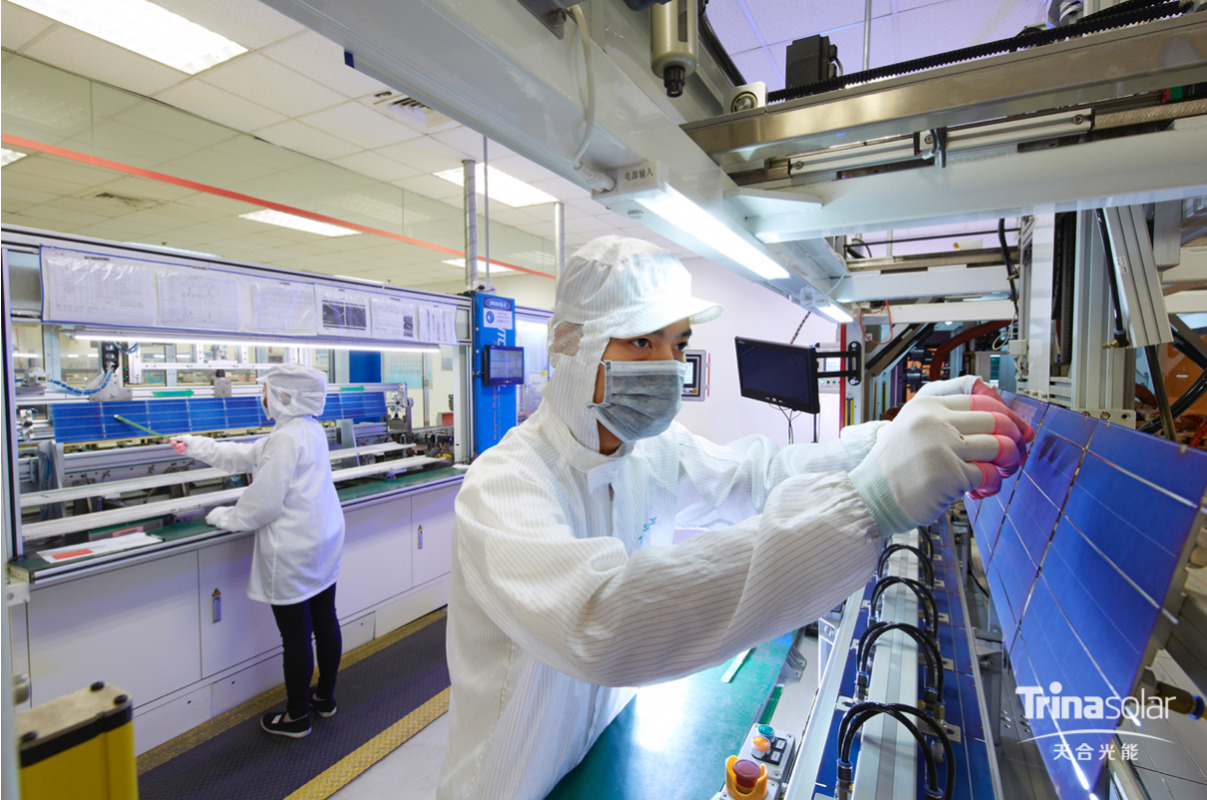
On January 22, Trina Solar announced that its first large size modules, with 210mm wafers – referred to as the 210 modules – had come off the production line. The long-established PV pioneer is looking to reclaim its leading position in the solar industry.
“We’ve noticed a window phase in the industry, which is a natural development. Trina Solar considers heavy asset and high investment from multiple aspects. Investment should address both the present and long term future development. The 210mm wafer requires optimum capacity of supply chain facilities, and thus will stand, in the coming 5 years, as an industry-leading technology and product, one not open to question.
Unlock unlimited access for 12 whole months of distinctive global analysis
Photovoltaics International is now included.
- Regular insight and analysis of the industry’s biggest developments
- In-depth interviews with the industry’s leading figures
- Unlimited digital access to the PV Tech Power journal catalogue
- Unlimited digital access to the Photovoltaics International journal catalogue
- Access to more than 1,000 technical papers
- Discounts on Solar Media’s portfolio of events, in-person and virtual
Or continue reading this article for free
“As a leading enterprise, we hope to see a unified size among all companies, which we foresee as an inevitable trend. The chaos of diverse product sizes will come to an end, and a new standard will be formulated. We look forward to facilitating the standardization of products, and accordingly, that of solar plants,” Yin Rongfang, vice general manager and executive vice president of Trina Solar, told PV Tech in an exclusive interview.
Yin expects the 210 module to see a good start in 2020 and achieve exponential growth in 2021. With required certifications for the 210 module well underway, the module is likely to make up 15-20% of the overall sales volume in 2020, according to Trina Solar’s plan.
Yin continued, “The demand for high efficiency is a general trend, while the 210 module performs exceptionally well in power enhancement. Trina started to look at 210mm technologies a year ago. We were pondering what size plants would actually be required in the future.
“We thought about the issue from several aspects, ranging from wafers, cell technology routes, transportation and installation and product weight, right to the end users. We also had broad conversations with enterprises engaged in these sectors. In terms of the wafer, we found 210mm to be a size that would not be challenged in the next five years, according to semi-conductor technology.”
Yin went on to say that the 210 module enjoys a strong competitive edge in production efficiency and energy consumption, as long as there is no significant drop in production speed, while solar plants can see a power boost from 400W to 500W delivered by the new module, thus reducing BOS costs. The competitiveness of the product remains undoubted in these two perspectives.
It is claimed that the 210 module can deliver power of 500W or higher, monofacial efficiency of up to 21%, and bifacial 20.7%, satisfying criteria for some high-requirement projects, such as China’s Super Leader Projects which require 20.4% efficiency or greater.
“As a product for generating electricity, solar modules are ultimately evaluated by the LCOE. The 210 module has a doubtless edge in this regard,” Yin continued.
Based on open source data and theoretical calculation, the 210 module, compared to other current mainstream modules, is capable of delivering a cost reduction of 0.1 yuan per watt or more, adding significant investment value to those plants employing this type of module.
The aim of Trina Solar’s 210
Trina Solar’s plan for the 210 module has brought a further touch of upheaval to an industry already in a ‘mess of sizes’. So, is Trina’s investment in 210 technology an opportunistic attempt to achieve a new breakthrough?
Yin said, “With fast evolving technology and intensified competition in the PV industry, the superior will prosper and the inferior will be eliminated. It is also important to note that it needs time for any new technology to be widely accepted. Trina Solar is cautious towards any technology that is immature and not yet accepted by the market, before applying it to mass production.
“Trina is an enterprise with a national laboratory and a large research team, an R&D strength capable in all related technologies. We were among the first companies to advocate MBB, and the first one to promote G/G modules. We have a lot of core technologies in module manufacturing. Also, with a large number of products already shipped to the market, we can conduct data analysis on those products. All these serve as factors supporting our consistent improvement in technology.
“Through this process, we find out which technologies can provide both competitiveness and sustainability when applied in the market. The 210 module is based on Trina Solar’s accumulation of technologies over a few decades. For its large size, we have to take into account the possible risks of combining existing technologies with the production of the new module. Now we have some good solutions to that, and have applied for a lot of patents. We have a clear picture in our mind, from early stage R&D and from supply chain to market layout, for the investment in the 210 module.”
Yin did not deny that a revolutionary product needs to address the challenge of further development. He continued, “A major challenge facing the 210 module lies in the cell and the equipment. We have to think about how to qualify the supporting equipment and coordinate the yield rate. The development of 210mm modules depends on that of the cells. As a result, we adjust our production scale and speed of the modules in accordance with that of the cells.
“And not only should we focus on the product itself, but also the facilities in power plants, as higher power means more current. Apart from modules, Trina Solar also has more downstream businesses such as the tracking system and product integration, which is an advantage we enjoy. Based on that, we have carried out research from the perspectives of product, system and application, to study how to match the performance of related facilities in the context of stronger currents.”
In terms of marketing, Yin said, “We have a directive road map, but that’s subject to adjustments required by different markets. At the same time, we prioritize markets with a high demand for new technology due to a limited capacity this year.”
Trina, among the front runners of globalization, is operating in Latin America, North America, Europe, the Middle-East, Africa, Asia-Pacific and China. Its global strategy is illustrated by its module shipments that have ranked the company in the world’s top three for several consecutive years.
“Our module shipments were over 10GW in 2019. The detailed data shows we have a good share in every market, and we are quite balanced among all the markets, which is a reason why we remain top 3,” continued Yin.

Underestimated modules to gain recognition
Trina Solar has launched an array of new businesses in the past two years, resulting in a slight drop in the module sector. Open source data shows module revenue accounted for 93.04%, 85.16% and 59.81% of the firm’s total respectively in 2016, 2017 and 2018. Some people questioned whether the module sector was undergoing a major adjustment.
Yin admitted that Trina Solar had experienced an adjustment period during 2017-2018. “Now we are almost out of the bend. We are accelerating. Our expansion, in particular with the 210 module, will be very fast.”
He stressed, “Modules are always a core business for Trina. We have extended our business to product integration, downstream development and even energy networks in the past two decades. While all these developments have been as a strategic deployment against the backdrop of the PV industry, we will not loosen our grip on modules.”
Responding to the decreasing share of revenue represented by the company’s module business, Yin brought up the phenomenon of lower price with higher shipment volume. “Our modules have decent shipment levels and growth, as well as an increasing market share. But interestingly, due to a drop in price, earnings from modules decreased despite larger shipments and, furthermore, with the rapid development of new areas of business, the module sector’s share of overall company revenue also dropped.
“So, the volume of module business is not decreasing, it is the dropping price that makes it look like it is going down.”
Yin believes an over-simplified understanding of the module business prevails in the industry.
“Different from silicon, wafers and cells that are intermediate products, modules, as the core part of a plant, are delivered directly to power plant investors, property owners and even local residents in more than 100 countries around the world. The business is reaching more individual customers, rather than in a mere B2B mode.
“Under such circumstances, a module company must meet high standards in terms of business operation, logistics, coordination, customer management, channel management and after sales service. And you have to tackle the different transaction practices in all of the countries, and more issues like politics, trade barriers, credit risks and currency hedging, which requires a comprehensive strength. In contrast, wafer and cell companies are free from 90% of these problems.”
“In my personal view, the module is grossly undervalued in the whole industry chain. Thanks to the supply chain, the industry now sees some dividends in wafer and cell production. But, in the long term, Chinese enterprises should prioritize business operation over immediate interests.
I firmly believe, with the maturing of the industry, the value of the module sector, which demands constant investment in new technology and products and, in the face of a complicated international market, strong competences in policy, exchange rate management, operations and post sales service, will be fully recognized by the market.”
